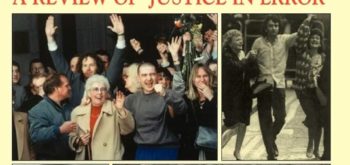
The Court of Appeal Criminal Division finally delivered its judgment in the case of Victor Nealon, three months since the successful appellant was released and turned out on the streets on Birmingham left to fend for himself – see HERE. Pic by Isobel Williams of Supreme Court gallery
The judgment and the back story behind this case serves as a depressing epitaph for the criminal justice system and its complete lack of progress since the notorious miscarriages on the late 1980s and early 1990s which led to the Runciman Committee and establishment of the Criminal Cases Review Commission.
To examine what went so badly wrong in this case, it is worth returning to the key facts. 0n August 8th 1996 the victim was subjected to an attempted rape outside a nightclub in Redditch. The attacker had been seen in the night club hours before and was described as having a noticeable lump to his forehead and a strong Scottish accent. After mauling the victim, he made his escape.
Victor Nealon had never been to the nightclub in question.
He was of Irish extraction and had a strong Irish accent. His facial disfigurement was due to serious acne and he did not have a lump. His mistake was however to be living in the area as someone who had in the past been convicted of offences.
Some weeks after his arrest Nealon was asked to stand on an ID parade which he readily volunteered to do. Significantly he had offered his DNA to the police officer involved with leading the case and understood this was to lead to testing against the clothing. Not only did that testing not occur but the exhibits, apart from a skirt remained, in their sealed evidence bags.
The court was not given the true position over the lack of forensic testing in the case.
Sadly this was only the start of Victor Nealon’s problems.
An ID parade was arranged and, in breach of the Police and Criminal Evidence Act, the same officer was present at the ID parade and spoke to at least one of the witnesses. The ID evidence that followed from other witnesses was equally poor and inadequate with one witness picking out but stressing the man involved had a strong Scottish accent. Other witnesses failed to pick out the applicant, including the victim’s friend who helped compile an e-fit.
The complainant herself did not attend the ID parade.
The preparation for trial in the case was wholly lacking and although the legal team raised questions over exhibits they failed to follow through those inquiries. This inadequacy was amplified by the approach to an alibi issue that arose.
Victor Nealon assumed he was at home when the offence occurred and once he was remanded in custody his new partner and her daughter tried to help by remembering which videos they watched at home which the daughter then recorded in her diary. They made a genuine mistake over the videos which the police seized upon.
Now firstly the defence team should have addressed this by making their own enquiries but more importantly, despite being in receipt of this evidence well before the start of Nealon’s trial, the Crown chose not to disclose it until after Nealon had given his evidence in chief. This was a tactical move designed to remove from Victor Nealon the opportunity to answer the issue.
Building a case
All of this conduct – the failure to undertake the DNA assessments, the misleading of the court, the collection of late rebuttal evidence and presence of the officer at the ID Parade – are all indicative of a disturbing approach to building a case against Victor Nealon at all costs.
Had those involved with the case chosen instead to investigate the case in a fair and open manner then the result would have been very different.
The DNA testing not finally done until 2009 was to show that the DNA present in all key intimate areas was that of an unknown male and not Victor Nealon. If this had been done in 1997 then a man would not have lost 17 years of his life.
As the Court of Appeal in its judgment noted:
‘Therefore, every sensible enquiry that could be made to identify a possible innocent source of the DNA has been made. It follows that the jury may reasonably have reached the conclusion, based on the DNA evidence, that it was a real possibility that the “unknown male” – and not the appellant – was the attacker.’
Of course, the conviction was not the end of the story for Victor Nealon.
Serious questions now arise as to how the Criminal Cases Review Commission handled the matter. Nothing should be taken away from its excellent third review which helped eliminate any possible innocent explanation for the DNA results. However its two earlier reviews were poor to say the least.
The reality is that the CCRC’s 1998 and 2002 decision and its refusal to undertake the tests consigned the applicant to serve a further 16 years in custody. It’s not only that this happened to Victor Nealon but that others may still sit in custody having been wrongly rejected by the Commission in the past.
Further at a time when public confidence in the police has been so shaken this case demonstrates that there has been little progress and that even after the fallout on the early 1990’s there remained a willingness to construct a case around a suspect rather than investigate the crime.
Perhaps the most disturbing aspect of this case is the implications it has for other exhibit cases and the long awaited determination of the Supreme Court on the case of Nunn. There can be no clearer demonstration of the dangers of preventing those who say they are wrongfully accused accessing exhibits. A failure to do so could consign more Victor Nealon’s to spend many decades in custody for crimes they did not commit.
The real problem is not what happened to Victor Nealon but the machinery of justice’s willingness to perpetuate such cases and when cases go wrong to simply stick a plaster on them and move on as if nothing happened. This is the drive to maintain the status quo and perceived integrity of the system at all costs.
It will not be until we take a root and branch review of how cases are investigated and prosecuted will we ensure that such notorious miscarriages do not occur in the future. It is an uncomfortable road to travel upon placing the interests of the accused at the centre and it also involves a challenging review of those who are responsible for delivering justice to the wrongfully convicted – not just the Criminal Cases Review Commission but also the Court of Appeal Criminal Division .
Until we are prepared to undertake such a review we will continue to perpetuate notorious miscarriage after miscarriage. Perhaps the time has now finally arrived to ask some uncomfortable questions.






